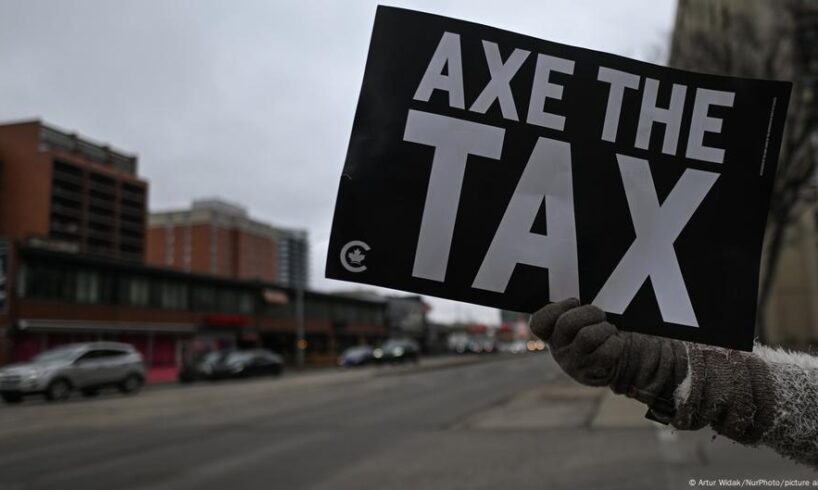
Ahead of Canada’s elections in May, “axe the tax” became one of the rallying cries against a consumer levy on CO2 emissions that conservatives said was “driving up” gas and heating prices during a “cost-of-living crisis.”
The tax wasn’t really a tax because money taken from consumers was returned via quarterly rebates, one of the policy’s main architects, Catherine McKenna, told DW.
“Free advice to anyone doing it: don’t call it a carbon tax. And if you make it revenue-neutral, the money goes back. It’s not a tax,” said the former Liberal Party minister for climate and environment.
Still, the price on carbon was met with a barrage of disinformation. McKenna even received personal attacks and needed security.
When the Liberals implemented the policy in 2019, McKenna thought she had done the hard work of drumming up broad support. Her team consulted with conservative lawmakers who favored such market-based climate solutions and did polling on how to message the carbon price for voters.
Former Canadian environment minister Catherine McKenna was one of the architects of the country’s carbon pricing schemeImage: Sean Kilpatrick/The Canadian Press/picture alliance
But the price on carbon became a political albatross. And as one of his first moves in office, new Liberal Prime Minister Mark Carney scrapped the price for consumers — once hailed as a model market-based solution for climate action.
For McKenna, the shift partly resulted from the Liberals “losing the resolve on the narrative” and not doing the work of explaining the policy’s value. But it’s also one of the latest examples of climate backtracking as governments try to balance who pays for transitioning away from fossil fuels in a way that doesn’t cost them at the polls.
Using sticks to pay for climate change
The cost of transitioning to renewable energy is hefty — about $2 to 4 trillion a year globally. But the price tag for inaction is much higher. By 2050, damages and lost income from climate disasters could reach $38 trillion annually.
Consumers, taxpayers and companies — or shareholders — are the three sources of cash that governments can tap to cover the cost, explained Gernot Wagner, a climate economist from Columbia Business School in New York.
“It can’t just be taxpayers. It can’t just be shareholders either. And it definitely can’t just be consumers either, right?” Wagner said. “The politics comes in when we are looking at trying to create the right balance between who pays.”
Could a carbon tax help address the climate crisis?
To view this video please enable JavaScript, and consider upgrading to a web browser that supports HTML5 video
In Canada’s case, it was consumers and companies paying. But it could also be taxpayers and companies or all three.
Wagner added that the different financial mechanisms for paying for decarbonization need to be weighed too. “It’s about finding ways to balance the carrots and the sticks,” he told DW. Sticks are disincentives like a carbon tax, which puts a price on each ton of CO2 emitted — similar to Canada’s scheme.
“One issue with the carbon tax is that tax, sadly, is a four-letter word,” said Wagner. “It tends to be difficult to get yourself elected by basically shouting carbon tax.”
McKenna said her party found it difficult to shake the “tax” label because people weren’t connecting the rebates they received to the CO2 pricing scheme, but they “were noticing it when they filled up their cars or looked at their energy bills” and saw the increased costs.
Wagner pointed to cap-and-trade systems as having more political staying power than Canada’s carbon price, like the EU’s Emissions Trading System.
Under this setup, a cap is placed on CO2 emissions and companies buy permits to pollute. A shrinking cap and fewer permits raise the cost of emitting and incentivize companies to decarbonize.
Paying to transition to green energy now will reduce the bill for future climate damages, say expertsImage: Jon G. Fuller/VW Pics/IMAGO
McKenna also acknowledged a cap-and-trade system might have been easier to keep in place, because it’s applied to companies rather than consumers, although the cost usually gets passed down. Canadian PM Carney kept the carbon price for heavy emitters like oil, gas and cement, which McKenna said aren’t paying enough for rising emissions.
“If we are not going to create incentives for consumers through a carbon price, then we need to ratchet up against big polluters,” said McKenna, adding that ahead of the Canadian elections, Carney talked about using money from industrial carbon pricing to subsidize things like switching to electric vehicles and heat pumps.
Getting climate subsidies right
Returning to Gernot Wagner’s carrot and stick metaphor, carrots are incentives such as subsidies. But even using carrots can land governments in hot water if messaging and design are off.
Germany’s rollout of a subsidy to help homeowners replace oil and gas heaters with climate-friendly heat pumps is just one example.
The policy’s projected costs and a proposed ban on new fossil fuel heaters caused serious backlash, with opposition parties and tabloids trashing the law and its main architects, the Green Party.
“In principle, that’s a good idea. But I think the structure is the crucial point,” Barbara Metz, executive director of the NGO Environmental Action Germany, told DW.
Heat Pumps: How cold rivers could heat your home
To view this video please enable JavaScript, and consider upgrading to a web browser that supports HTML5 video
Under the policy, Germany’s government offered subsidies covering up to 70% of the cost of a heat pump and installation. But that percentage-based structure incentivized companies to inflate heat pump costs to €30,000 and extend installation to 18 days. In the UK, Denmark and Poland, they cost €15,000 and take two days to install.
To bring costs in line with other countries, Metz’s NGO advocates for a fixed-price subsidy, because the policy only works if heat pumps “can compete with the cost of gas and oil heating.”
A typical oil or gas heater costs around €7,000. With an €8,000 subsidy, a €15,000 heat pump would cost the same. With the promise of lower energy bills on top, homeowners would be more likely to select the heat pump.
“That’s math,” said Metz. A fixed-price subsidy would speed up installations and halve taxpayer spending.
Paying for greenhouse gas pollution and adaptations necessary to cope with the changing climate is complex, said Catherine McKenna. Some policies will work, and others will need adjustment and there will likely be industry or public pushback. But the cost of inaction will be much greater.
“You know, it’s been really hard to be honest,” said McKenna. “Like, hard things are hard and nothing is harder than climate policy.”
Edited by: Jennifer Collins
Charli Shield also contributed reporting to this article.
For more on this topic and more on the Costs of Climate Change, check out our Living Planet podcast series.This story is part of ‘The 89 Percent Project,’ an initiative of the global journalism collaboration Covering Climate Now.





